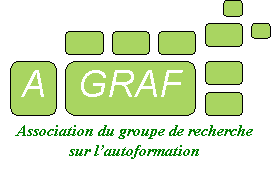|
| |
 Research
on Self-Direction in Learning in
the United States Research
on Self-Direction in Learning in
the United States
by Lucy
M. Guglielmino - Symposium
sur l'autoformation - Royaumont, juin 2000
I. a brief chronology
- 1961. Cyril Houle, The inquiring Mind
- Adult learners are goal oriented, activity oriented or learning
oriented
- 1965. Johnstone and Rivera, Volunteers for Learning
- Extensive study of participation in adult learning in the
US revealed that 8% of adults in the US were involved in at least
one major self-education project in year sampled (1961-62). " Self-instruction
is probably the most overlooked ... activity in ... adult education "
- 1966 ; Jerome Bruner, Toward a theory of instruction
- Describes it as " the provisional state that has
as its object to make the learner or problem-solver self-sufficient "
- 1969. Carl Rogers, Freedom to learn
- Teacher as facilitator, encouragement of self-direction in
learning
- 1970. Malcom Knowles, Modern practice of adult education
- Presented assumptions of andragogy : " #1,
adults are self-directed in other areas of their lives, and therefore
prefer SDL
- 1975. Malcom Knowles, Self-Directed Learning
- " Why and How to " of SDL for teachers
and learners
- 1971, 1979. Allen Tough, The Adult Learning Projects
- Extensive research on " adult self-learners ",
how they learn, how many learning projects they complete on their
own per year, resources used ...
- Median of 8 learning projects per year, 70% self-planned
- Many other studies used his interview schedule
- 1976. Roger Hiemstra, Life Long Learning
- Discussion of andragogy as an evolving theory area
- 1979. Huey Long, Continuing Education of Adults in Colonial
America
- Descriptive research emphasizing self-learning during this
period
- 1977. Lucy Guglielmino, SDLRS & LPA
- 3-round Delphi study to arrive at characteristic of self-sirected
learner, resulting in tentative definition
- Development of Self-Directed Learning Readiness Scale (SDLRS)
as well as Learning Preference Assessment (self-scoring form with
Paul Guglielmino)
- Validation studies, correlational studies, meta-analysis,
cross-cultural comparisons
- 1980. Maurice Gibbons et al.
- Quantitative study of experts who were self-taught
- 1989. Sandra McCune, A Meta-analytic study of Self-Drection
in Adult Learning, (1977-1987)
- Identified most frequently used research tools (Guglielmino's
SDLRS and Tough's interview schedule)
- Verified a variety of variables associated with self-direction
in learning across studies using different methodologies
- 1983 - present. International Symposium on Self-Directed
Learning (annual) coordinated by Huey Long
- Promotes research and its dissemination, through publication
of selected papers each year
- 1984. Spear & Mecker
- Based on qualitative research, presented the concept of the
organizing circumstance (environmental influence of SDL)
- 1984. Lorys Oddl
- Development of an instrument to measure self-directed continuing
learning of professional ( Oddl Continuing learning inventory)
- 1985. . Stephen Brookfield, Self-Directed Learning :
from theory to practice (and many other publications)
- Included a critical review of SDL research
- Emphasized interdependence of self-directed learners
- 1989. Huey Long, SDL as interaction between psychological
and pedagogical control
- 1991. Huey Long, Interaction model for analysis of interacting
variables in SDL
- Compilations of SDL Research
- 1991. Long & Confessore, Abstracts of Literature in SDL
1966-1982
- 1992. Confessore & Long, Abstracts of Literature in SDL
1983-1991
- 1992. Long & Redding, SDL Dissertation Abstracts
- 1991. Breckett & Hiemstra, Self-Direction in Adult Learning
- 1991. Breckett & Hiemstra, Personal Responsibility
orientation model
- Individuals taking responsibility for their own learning is
central
- Self-Direction can be seen as both an instructional method
(self-directed learning) and a personality characteristic (learner
self-direction)
- The Social context in which learning takes place is important
- 1991. Gerald Grow
- Developed a model of four stages of readiness for self-direction
learning
- 1996. Jane Pilling-Cormick
- Developed Self-Directed Learning Perception
- 1996. Gary & Sharon Professore
- Developed Learner Autonomy Profile
II. Classification Shemes
- 1985. Ralph Breckett, Three distinct streams of Inquiry
- Descriptive research
(based on Tough's interview schedule)
- Quantitative research
(focused on the relationship between self-directness and a variety
of psychosocial varaiables, primarly through use of SDLRS)
- Qualitative studies
(Bookfield, Gibbons, Mexker & Spear, Leean & Sisco)
- 1988. Caffarella & O'Donnell , Five categories
- Nature of the philosophical position
(conceptual perspective of the process)
- Verification studies
(descriptive investigations of learning process)
- Nature of the method of SDL
- Nature of the individual learner
- Policy questions
- 1999. Merriam & Caffarella, Learning in Adulthood,
look at SDL research in 3 broad categories
- Related to goals of SDL
- Examining self as a process or form of study
- Considering self as a personal attribute of the learner
|
